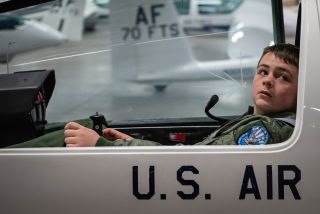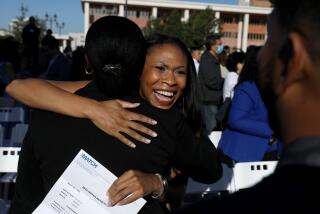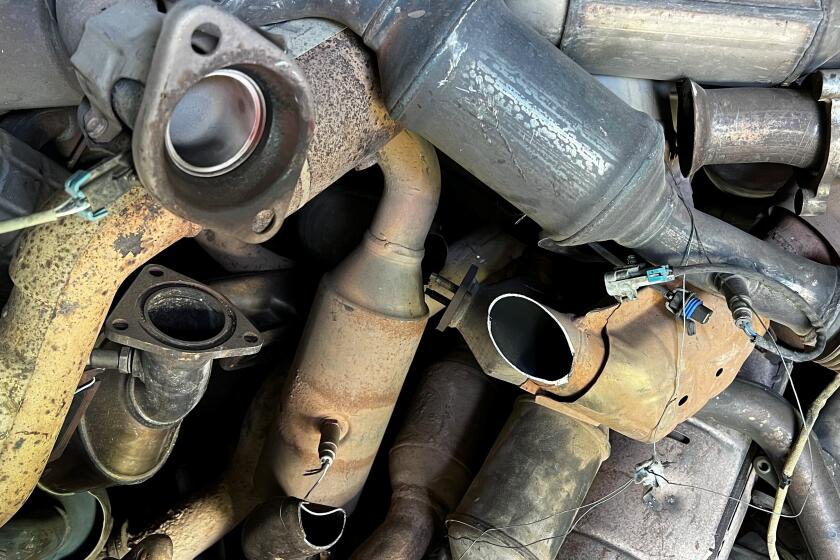Cancer educates a med student
- Share via
Joshua Lilienstein lined up for treatment this summer at Los Angeles County-USC Medical Center’s general oncology clinic. A medical student who’d been battling cancer for four years, Lilienstein had little choice. In June 2009, he lost his insurance after maxing out on the lifetime benefit.
At 30, Lilienstein found himself playing two roles: a patient negotiating the county’s options for the uninsured and a medical student working the halls of the same hospital to finish a demanding 12-week surgery rotation.
The line at the metal detector near the county’s oncology clinic snaked out the door. Lilienstein, who’d arrived straight from morning rounds in his doctor’s coat, stood out among the patients. Security guards took one look at his white jacket and ID badge and waved him through.
He was in his first year of medical school at USC when doctors diagnosed testicular cancer. At the time, he was insured by Anthem Blue Cross through the student health insurance program.
Lilienstein sought treatment at USC Norris Comprehensive Cancer Center, one of the nation’s leading cancer research and treatment sites. He withdrew from school three times for chemotherapy and surgery so radical, doctors called it “heroic” — removing his testicle, clusters of tumors, portions of his liver and bowel, his spleen and lymph nodes and replacing bone marrow destroyed by chemotherapy with a transplant.
In January, six months into remission, Lilienstein returned to complete his third year of medical school. By then he was among the more than 2 million uninsured Los Angeles County residents.
The oncology clinic’s waiting room was packed. It was a far different crowd than at Norris. Most of the patients were minorities; many Latino, Spanish speakers. Some had amputations. They looked desperate and broken.
How strange, he thought, that I look like the healthiest person in the room.
He was handed a financial questionnaire full of small print. He looked around the room, wondering how many of his fellow patients would understand their options.
When he returned hours later to wait for his appointment, a loudspeaker blared names. The voice was harsh to Lilienstein’s ears. Chemotherapy had damaged his hearing, leaving him dependent on hearing aids. He could not understand the voice on the loudspeaker. Many others in the room were also struggling.
Fellow patients, noticing his white coat, assumed he was a clinic doctor and approached him for help.
“I’m Gonzalez,” one man said. “Are you looking for me?”
When Lilienstein told the man he was not his doctor, he wilted back into his seat.
Within the hour, a resident was recording Lilienstein’s medical history in an exam room. Lilienstein wondered if he was getting preferential treatment and vowed to leave his doctor’s coat behind next time.
When his oncologist arrived, they spoke briefly, reviewed his records and confirmed the blood tests he would have that day. After about five minutes, the oncologist moved on. Doctors at Norris usually spent more time with Lilienstein, but their clinics were not inundated with chronically ill uninsured and underinsured patients.
These are the moments when Lilienstein thinks about the paradox of public hospitals and the promise of national health reform.
“County is an amazing public service; look at all these hundreds of people getting free or low-cost medical care. But on the other hand, there’s a stark class division in terms of access to medical care and engaging with the medical system that’s very uncomfortable,” he said. “This is not how it looks in other developed countries. We can do better.”
**
On a midsummer day not long after his first appointment at the county clinic, Lilienstein greeted Lydia Nueva Espana, 77, in the preoperative area at the private USC University Hospital, a short walk across the medical campus from County-USC.
Lilienstein does not tell every patient he is a cancer survivor. Sometimes it can be a distraction. But other times, his story can offer encouragement.
He had shared his history with Nueva Espana, whose battle with breast cancer had begun in 1978, before Lilienstein was born. She had a mastectomy soon after her initial diagnosis more than three decades ago, but the cancer had recurred three to four years ago.
Nueva Espana was already in a hospital gown, and as nurses settled her onto a gurney, Dr. Stephen Sener, the cancer surgeon, arrived to explain how he and two other surgeons would remove the lump and rebuild her breast.
“It’s what that medical student had: multi-disciplinary surgery,” Sener said, pointing to Lilienstein as Nueva Espana beamed.
Doctors who survive cancer and return to work show a different perspective and dedication, Sener said, adding of his younger colleague: “He doesn’t have to be here — he could have just curled up in a ball.”
From the start, Lilienstein resisted fearing his illness. He chronicled and examined his treatment on a blog. He let his parents post photographs of his last surgery online.
“This time of illness,” he said, “has been fascinating.”
Still, he second-guessed himself at the start of the summer, questioning whether he should return to the demands of medical school.
“The kind of stress that I will have to endure as a medical student and a resident is something that ruins normal people’s bodies and minds,” he said. “As opposed to some random genetic thing that had messed with my life, this would be me making the wrong decision.”
Knowing he was uninsured only added to the pressure. He already owed more than $30,000 to USC, Stanford Hospital and Memorial Sloan-Kettering Cancer Center in New York for cancer treatments and surgery. Collections agents were calling.
In the operating room, Lilienstein stood by as a thoracic surgeon sewed a protective mesh over Nueva Espana’s lungs.
“Somebody hold that. Don’t pull it — hold it,” the surgeon ordered.
The surgeon and Sener had removed a fist-size hunk of cancerous tissue from Nueva Espana’s breast and sections of two of her ribs. Lilienstein, standing across from the surgeons, helped them stitch the mesh, holding one of the threads in place with a metal clamp.
They have been on their feet for about two hours. Lilienstein was in awe of the surgery, the most radical he had seen. To him, it was both beautiful and terrible. Beautifully done, terribly painful to recover from.
Soon, Dr. Alex Wong, a plastic surgeon, arrived and took over, slicing into Nueva Espana’s abdomen with the help of a resident to find the muscle he would use to rebuild her breast. Lilienstein held back surrounding tissue with a metal retractor.
“So, you’re finishing your third year,” Wong said. “Have you thought about what you want to do?”
Lilienstein was not sure what sort of doctor he wanted to be. He wanted to improve cancer therapies, translating advances in genomic science into new treatments. Maybe he should be a radiologist, he said, or a hematologist-oncologist.
“And I’m still recovering,” he said, explaining his diagnosis of metastatic testicular cancer.
Wong took that in stride. He asked which doctors Lilienstein had seen. The medical student eagerly detailed his own case.
“The added drama is that I maxed out my health insurance, so I’m uninsured.”
The resident who’d been helping Wong looked confused. How could a medical student be uninsured?
Lilienstein understood. His medical school professors rarely discussed health insurance. He remembered a single lecture during his first year that was so complicated, even the instructor threw up his hands.
“It’s sort of this space in our healthcare system,” Lilienstein said.
He had to leave surgery for a noon appointment at the county oncology clinic, so he did not tell the resident the latest news: He had been told he would soon be insured.
University officials had recently notified him that the student health plan was switching from Anthem Blue Cross to Aetna. He was eligible to enroll, despite his pre-existing condition and lapse in coverage.
Wong was winding down, preparing to stitch up Nueva Espana’s incisions. Lilienstein left for his scheduled CT scan. The resident shouted after him.
“Good luck on your CT!”
**
Lilienstein walked briskly across campus, still thinking about Nueva Espana’s surgery, considering decisions the surgeons made and how they would affect her recovery.
At the diagnostic and treatment tower, he did not have time to take off his white coat before he reached the metal detector, where security guards again waved him past the line. He found the fourth-floor CT scan waiting area nearly empty, a television in the windowless room blaring a World Cup soccer game.
A radiology technician appeared and told him he had just missed the morning rush.
“Usually, the line is out the door,” Lilienstein said.
The technician handed Lilienstein two bottles of a chalky, banana-flavored drink full of barium, a metal that would increase the contrast on his CT scan, allowing doctors to better examine his internal organs for signs of cancer. Lilienstein choked it down, making faces.
Back in Palo Alto where he was raised, his parents were watching the phone. So was his girlfriend in New York.
He thought again about his future and whether he should specialize in radiology, which would mean less time with patients.
“I get a lot out of being with patients,” Lilienstein said. “It’s very reflective. You’re constantly thinking about what it is to be sick, what it is to be a patient, what it is to be alive.”
He walked next door to a darkened room where the white CT scan machine loomed like a spaceship. The equipment, which the technician said was purchased when the new hospital building opened in 2008, was a “vast improvement” over the old county hospital facility next door and better than what Lilienstein had been examined with at Norris Cancer Center, he said.
He lay down on the machine as the technician retreated to a nearby room full of computer monitors. Moments later, the screens flashed images of Lilienstein from breast bone to groin. He got up walked over to examine the images.
“If I do have disease, it’s not grossly evident,” he said.
He pointed to the space where his spleen used to be, the surgical clips left over from his last operation, the missing chunk of his liver, scar tissue and white spots that might be the beginnings of tumors.
A radiologist reviewed the scan and attempted to connect to the computer system at Norris. She wanted to compare the scan to Lilienstein’s last one in February. But the computers failed to connect, a frequent problem, she said. She promised to call him once she found his records.
Lilienstein walked back outside, headed for clinic consultations. He noticed there was still a line at the metal detector.
Suddenly, his cellphone rang. It was the radiologist. She had walked over to Norris and checked his records. His CT scan was unchanged.
“Great news,” Lilienstein said as he typed text messages to his parents and his girlfriend. “It’s a great day.”
molly.hennessy-fiske@latimes.com
More to Read
Sign up for Essential California
The most important California stories and recommendations in your inbox every morning.
You may occasionally receive promotional content from the Los Angeles Times.











